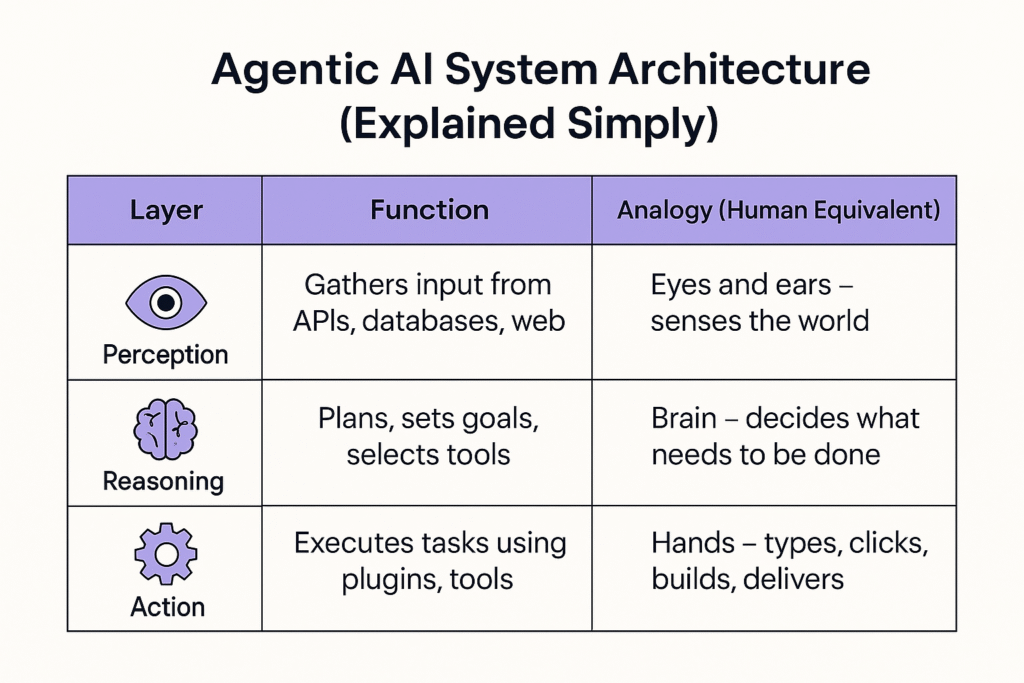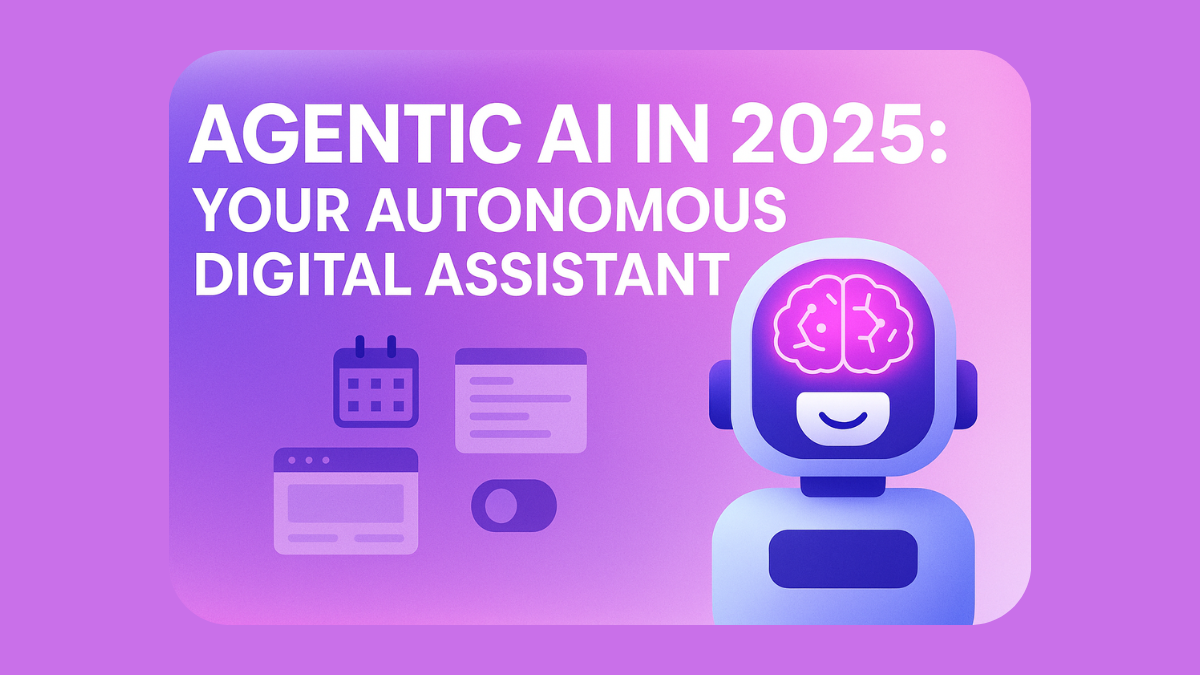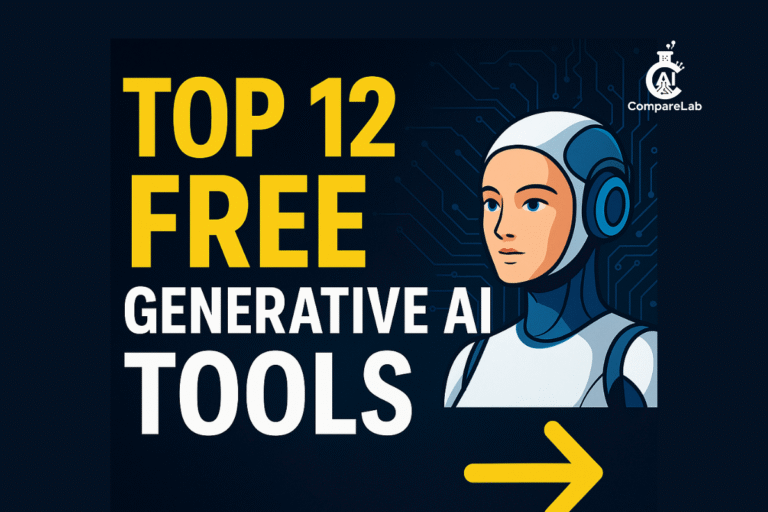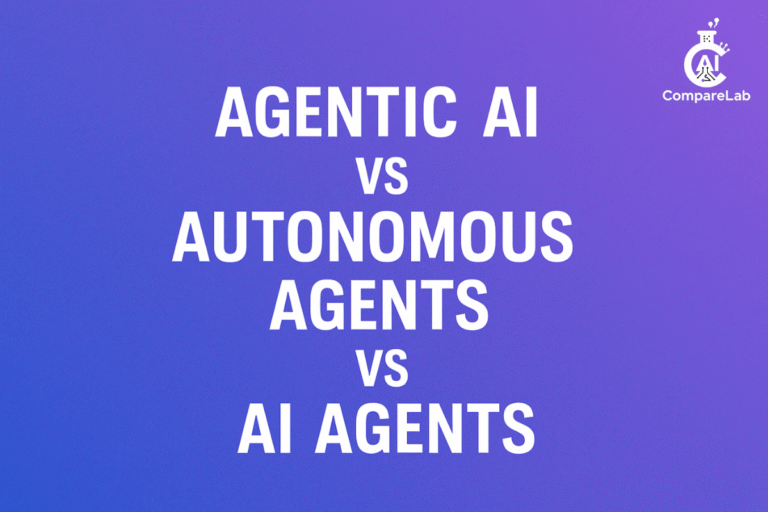Welcome to the Age of Autonomous Assistants – Agentic AI
“Don’t tell me how to do it. Just tell me what you need.”
That’s not your overworked team member talking. That’s your Agentic AI Autonomous Assistant in 2025. We’re officially entering a new phase of artificial intelligence—where assistants don’t just follow commands, they take goals and run with them. These aren’t your average chatbots or task managers. They’re digital colleagues that plan, decide, execute, and improve autonomously. In this article, we’ll break down what Agentic AI is, how it’s different from traditional AI tools, and why it’s about to redefine productivity, business automation, and your daily workflow. By the end, you’ll know exactly how to leverage it—whether you’re a solo entrepreneur, a tech leader, or just trying to stay ahead of the AI curve.
What Is Agentic AI? (And Why Now?)
Forget reactive bots. Welcome proactive agents. Agentic AI refers to a new class of AI systems that go beyond narrow, instruction-based tools. These systems autonomously pursue goals—breaking them into subtasks, executing them, adapting along the way, and learning from results.
🔄 Traditional AI vs. Agentic AI
| Traditional AI | Agentic AI Autonomous Assistant | |
|---|---|---|
| Follows commands | ✅ Yes | ❌ Not needed |
| Sets own subgoals | ❌ No | ✅ Yes |
| Tool use | Limited, predefined | Dynamic, multi-tool workflows |
| Adaptability | Low (rule-based) | High (contextual reasoning) |
| Learning | From data only | From feedback + outcomes |
Unlike standard AI chatbots that require step-by-step input, agentic systems are given a desired outcome—and they figure out the rest. “Plan my Tokyo business trip.” Instead of replying with a list, your assistant books flights, checks your schedule, renews your passport, and notifies your boss. These agents are built on frameworks like CrewAI, LangChain, OpenAI Function Calling, and Microsoft AutoGen—technologies enabling AI to reason, decide, and act in multi-step chains across tools. And why now? Because the infrastructure, APIs, and language models (like GPT-4o) have finally matured to handle real-world complexity.
The Big Shift — From Task Execution to Strategic Delegation
Traditional AI agents helped you do more tasks faster. Agentic AI helps you stop doing the tasks altogether.
🎯 From To-Do Lists to Strategic Outcomes
Instead of micromanaging every step — “open this spreadsheet, summarize that PDF, email the client” — you now say:
“Clean up my CRM and schedule follow-ups with top leads this week.”
And it gets done. Without hand-holding. This is strategic delegation, not task delegation. Think of the difference like this:
| Mindset Shift | Before (Traditional AI) | Now (Agentic AI) |
|---|---|---|
| Focus | Step-by-step commands | Outcome-first delegation |
| Input style | Detailed instructions | Goal-driven prompts |
| Role of user | Operator | Orchestrator |
| Mental bandwidth required | High | Minimal |
You become the project manager, and your AI handles the execution. This shift isn’t just a tech upgrade — it’s a productivity revolution.
Real-World Use Cases That Are Already Here
Agentic AI might sound futuristic, but it’s already reshaping how work gets done—across individuals, startups, and enterprises.
🧍 Personal Productivity
“Plan my Tokyo trip.” Your assistant books flights, renews your passport, syncs with your calendar, and even reminds you to pack an umbrella (rain’s expected Friday).
🏢 Enterprise Automation
“Route all high-priority tickets to senior engineers and notify customers.” Agentic systems connect to helpdesk tools, prioritize tickets based on sentiment, and act autonomously—zero human triage.
🛠 Creator Stack
“Launch an AI podcast this quarter.” With tools like AutoGPT or CrewAI, a team of agents can:
- Research trending topics
- Draft scripts
- Edit audio
- Schedule promos
No editing suites. No spreadsheets. Just oversight.
What Powers Agentic AI (Tech Behind the Magic)
Behind the curtain of Agentic AI lies a symphony of frameworks, models, and architectures working in sync — the unsung heroes enabling autonomy.
🧩 Core Components of Agentic AI Systems
Agentic AI isn’t built like your average chatbot. It’s an autonomous system architecture, typically composed of three layers:
| Layer | Function | Symbol |
|---|---|---|
| Perception | Ingests inputs from text, voice, APIs, or files | 👁️ |
| Reasoning | Breaks down goals, plans strategies | 🧠 |
| Action | Executes using tools, APIs, or internal skills | ⚙️ |
Each layer feeds into the next, enabling the agent to understand, decide, and act without ongoing input.
🔧 Frameworks Powering the Revolution
These aren’t sci-fi concepts — they’re already being deployed using a growing ecosystem of agentic frameworks:
🔹 LangChain
Provides memory, tool integration, and chaining logic. Think of it as the “brainstem” of your agent.
🔹 Microsoft AutoGen
Optimizes multi-agent coordination and open-ended task handling at scale.
🔹 CrewAI
Specializes in multi-role agent orchestration. Build teams of agents that mimic a real team: Researcher, Writer, Reviewer.
🔹 OpenAI Function Calling
Allows LLMs to trigger external functions—like running code, fetching data, or sending emails—securely and reliably.
Example in action: Say: “Give me a 3-slide pitch on solar tech.” Your agent uses LangChain for memory, Function Calling to access a presentation builder, and CrewAI to divide tasks among 3 roles.
⚙️ These Tools Work Together — Autonomously
Together, they let agents:
- Ingest prompts or goals
- Choose which tools to activate
- Use APIs, CRMs, spreadsheets, and databases
- Learn from outcomes to improve next time
It’s like hiring a team of tireless digital freelancers — who don’t sleep, get bored, or burn out.
Deep Dive – CrewAI and AutoGPT in Action
Let’s break down two of the most popular frameworks leading the charge in the Agentic AI movement — CrewAI and AutoGPT. They aren’t just tools; they are the foundation of entire autonomous workforces.
👥 CrewAI: Build a Team of Specialized Agents
Think of CrewAI as your virtual project manager — assigning tasks, monitoring outputs, and ensuring collaboration between agents.
🔧 How It Works:
You assign a goal: “Summarize the top 3 AI trends from 2025 reports.” CrewAI spins up:
- A Researcher Agent to fetch reliable sources
- A Writer Agent to convert findings into concise points
- A Reviewer Agent to fact-check and polish
Each agent has its own “personality,” skillset, and boundaries — and they talk to each other. You don’t instruct every step; you delegate the goal.
💡 Human Parallel: Just like a content team in a newsroom — researcher, writer, editor — except your team runs on code.
🤖 AutoGPT: Goal-Oriented Execution Engine
AutoGPT is your autonomous problem-solver. You give it a high-level mission, and it breaks it down into sub-goals, picks tools, and executes — all with minimal input.
🧠 Real-Life Example:
Say you want to launch a podcast about Agentic AI. You say: “Create and publish an AI podcast episode.” AutoGPT:
- Researches top trends and sources
- Writes the episode script
- Generates voiceover
- Publishes to podcast platforms
- Creates a promotion plan
It’s not just automation — it’s delegation.
⚔️ CrewAI vs AutoGPT: What’s the Difference?
| Feature | CrewAI | AutoGPT |
|---|---|---|
| Focus | Multi-agent teamwork | Single agent breaking down and executing |
| Task Handling | Role-based distribution | Goal decomposition and linear execution |
| Use Case | Editorial workflows, marketing teams | Product launches, research missions |
| Flexibility | Higher collaboration control | More autonomous end-to-end tasking |
🚀 Why it matters: These tools are not future tech. They’re already being used by startups, solo entrepreneurs, and enterprises to cut project timelines from weeks to hours.
Agentic AI System Architecture (Explained Simply)
Agentic AI isn’t magic. It follows a structured pipeline — just like a human does when solving a task. The power lies in how it perceives, thinks, and acts — all in loops.

🔄 The 3-Layered Architecture of Agentic AI
Let’s break it down into a simple visual structure:
| Layer | Function | Analogy (Human Equivalent) |
|---|---|---|
| 🧿 Perception | Gathers input from APIs, databases, web | Eyes and ears — senses the world |
| 🧠 Reasoning | Plans, sets goals, selects tools | Brain — decides what needs to be done |
| ⚙️ Action | Executes tasks using plugins, tools | Hands — types, clicks, builds, delivers |
🧭 Example Flow: “Plan My Tokyo Business Trip”
Here’s how this 3-layer system would work:
Perception
- Pulls your calendar, email threads, visa requirements, and budget constraints.
Reasoning
- Prioritizes meetings, identifies best flight schedules, finds hotel options close to your venues.
Action
- Books flights, sends calendar invites, files visa paperwork, and creates an itinerary.
And it doesn’t stop. It learns from delays, rebooks proactively, and improves next time. That’s adaptive automation.
📌 Why this matters: Most automation tools stop at execution. Agentic AI systems adapt — they make decisions, adjust mid-task, and deliver outcomes without being told how.
Why This Changes Productivity Forever
Agentic AI doesn’t just improve productivity — it redefines it. The shift is not about doing things faster; it’s about changing what we, as humans, spend time doing in the first place. In traditional workflows, productivity means optimizing tasks, minimizing errors, and increasing throughput. But that assumes you’re still the one doing the work — writing, researching, booking, coding. Agentic AI breaks that mold. It becomes your autonomous digital assistant, handling the operational load while you focus on direction, strategy, and creativity.
From Execution to Orchestration
Think of it like moving from being a factory worker on the line to becoming the conductor of an orchestra. You no longer write each email or analyze each spreadsheet — you tell your AI agent the goal, and it executes across tools and APIs to deliver the result.
| Before Agentic AI | With Agentic AI | |
|---|---|---|
| Writing daily reports manually | Agent compiles insights from dashboards | |
| Booking travel step by step | Agent compares, books, and syncs calendar | |
| Searching for research articles | Agent summarizes, links, and drafts notes |
This Isn’t Just Automation — It’s Adaptation
Unlike static automation scripts or tools, Agentic AI adapts. It doesn’t just repeat workflows — it modifies them when new inputs or obstacles arise. This is the beginning of cognitive automation — where systems learn, self-correct, and improve without human prompts. And that changes everything:
- Meetings become shorter — AI agents prep summaries, outcomes, and action items.
- Research accelerates — AI scouts, compiles, and prioritizes relevant insights.
- Creativity scales — writers, designers, marketers collaborate with specialized agents.
“Agentic AI doesn’t just save time — it reallocates it to higher-value thinking.”
Who Benefits Most from Agentic AI?
Agentic AI isn’t just for tech companies or advanced developers. Its versatility makes it a transformational tool across professions, industries, and business sizes.
1. Solopreneurs and Creators
For solo creators juggling content, marketing, and monetization, Agentic AI acts like a virtual team. It helps:
- Write blog posts based on SEO trends
- Schedule and post on multiple platforms
- Analyze traffic and suggest growth experiments
2. Small and Medium Businesses (SMBs)
SMBs often lack deep IT support. With Agentic AI:
- Automate customer support via autonomous workflows
- Generate invoices, track leads, send follow-ups
- Coordinate logistics and vendor communication
3. Enterprise Teams
Large organizations can tap into Agentic AI for:
- Automating routine reporting and dashboards
- Streamlining cross-department collaboration
- Coordinating multi-step operations like onboarding or audits
4. Researchers and Analysts
Agentic agents can autonomously:
- Scan hundreds of papers and articles
- Summarize findings and generate citations
- Maintain context across research threads
5. Developers and Tech Teams
Developers use Agentic AI to:
- Spin up dev environments
- Write test cases or documentation
- Chain multiple scripts and API calls across systems
“From students to CEOs, Agentic AI lowers the barrier between your ideas and their execution.”
No matter your role, if you manage goals that require coordination, data, or creativity — Agentic AI has a place in your toolkit.
Why Now? What Changed in 2025?
The shift to Agentic AI didn’t happen overnight. Several key breakthroughs in 2025 created the perfect storm for adoption:
1. Multimodal AI Became Mature
AI models like Gemini 1.5 and GPT-4o blurred the line between text, voice, code, and vision. Now, a single agent can:
- Read documents
- Interpret charts
- Transcribe audio
- Analyze webpages
All in one continuous task chain — making end-to-end autonomy possible.
2. Tools for Agents Got Smarter
Frameworks like CrewAI, LangChain, OpenAI Function Calling, and Microsoft AutoGen enabled developers to build agents with:
- Role-based memory
- Tool orchestration
- Goal prioritization
These frameworks became plug-and-play in 2025 — no longer reserved for researchers.
3. Infrastructure Caught Up
Cloud-native execution environments (like Modal, Replicate, Fireworks AI) made it easy to deploy and scale agents that operate across services and APIs. You don’t need to host models — you just define the outcome.
4. Demand Surged for Automation
The economic pressure to “do more with less” collided with talent shortages. Companies looked to AI not as a gimmick — but as a necessity.
- AI agents began replacing offshore back-office tasks
- Teams started using personal AI co-pilots
- VC funding flowed into agentic platforms
5. Users Got Comfortable
ChatGPT, Claude, and Gemini normalized daily AI interaction. When people saw that these tools weren’t just chatbots — but could work independently — demand exploded.
“2025 wasn’t just another year in AI — it was the tipping point when autonomous assistance moved from prototype to production.”
The technology matured, the infrastructure scaled, the user mindset shifted — and now, Agentic AI is the new baseline.
The Architecture Behind Agentic AI
Behind the magic of Agentic AI lies a carefully orchestrated architecture that blends perception, reasoning, and action — mimicking how humans operate, but at scale and speed.
The Three-Layered Stack
Agentic AI systems operate on a layered model that enables autonomy:
1. Perception Layer (Input & Context Gathering)
- Ingests diverse data formats: text, images, audio, PDFs, websites
- Extracts relevant signals: deadlines, goals, constraints
- Maintains dynamic memory of ongoing context
Think of this as the eyes and ears of your AI assistant.
2. Reasoning Layer (Decision Making & Planning)
- Breaks down goals into subtasks and sequences
- Chooses tools, APIs, and agents to complete them
- Prioritizes based on outcomes, efficiency, or constraints
This is where your assistant “thinks”—weighing options, adjusting plans.
3. Action Layer (Execution & Feedback)
- Executes commands across software and services
- Validates results, checks for errors, retries intelligently
- Loops feedback back into memory for future refinement
Like a self-correcting employee who learns from doing.
A Simple Use Case, Architecturally Mapped
Goal: “Plan a product launch for Q4.”
| Layer | What Happens |
|---|---|
| Perception | Gathers market data, team calendars, launch dependencies |
| Reasoning | Outlines campaign stages, aligns tasks to team availability |
| Action | Books meetings, sends briefs, monitors task completion via project software |
This architecture is what enables Agentic AI to move beyond one-off answers and toward full autonomous task execution.
The Key Agentic Frameworks Fueling This Shift
Agentic AI isn’t just a concept — it’s already being built, deployed, and tested in real-world scenarios. At the core of this movement are several open-source and enterprise-grade frameworks that are rapidly evolving the agent ecosystem.
🚀 CrewAI – The Multi-Agent Workflow Maestro
CrewAI enables collaborative workflows across multiple AI agents, each assigned a role like researcher, planner, or writer. These agents interact, debate, and refine output collectively.
- Ideal for research-heavy tasks
- Supports memory, tool use, and dynamic role assignment
Picture CrewAI as the command center of an AI newsroom.
🔄 LangChain – The Context-Aware Brain
LangChain connects large language models with external tools, memory, and real-time data. It’s built for chaining multiple steps and retaining context across them.
- Works seamlessly with OpenAI, Anthropic, and local models
- Powers reasoning chains and recursive decision flows
Think of LangChain as the central nervous system of your AI stack.
🧠 OpenAI Function Calling – Structured Action Interface
OpenAI’s function-calling API enables models like GPT-4 to execute real-world tasks — from querying databases to making calendar entries — using well-defined schemas.
- Great for precise task execution
- Enforces safety and interpretability through strict schemas
It turns language into structured, trustworthy automation.
🧭 Microsoft AutoGen – Autonomous Loops, Supervised Safety
AutoGen empowers agents to form collaborative groups, iterate until they achieve a goal, and ask humans for guidance when needed. It blends autonomy with a human-in-the-loop system.
- Best for enterprise use cases
- Supports advanced debugging, evaluation, and fine-tuning
AutoGen is your AI team that knows when to knock on your door.
Together, these frameworks form the bedrock of the Agentic AI revolution — making autonomy programmable, safe, and scalable.
Human in the Loop: The Manager Role
Autonomy doesn’t mean removing humans — it means upgrading our role from micromanagers to strategic overseers. Agentic AI empowers humans to act more like managers of intelligent workflows than executors of repetitive tasks.
From Operator to Orchestrator
You’re no longer writing step-by-step instructions. Instead, you:
- Define a desired outcome
- Oversee progress checkpoints
- Intervene only when needed
Think of it like managing a smart team — not babysitting a machine.
What the Human Still Owns
Even the most autonomous agents need human:
- Governance: Are decisions aligned with ethical and legal frameworks?
- Values: Are agents optimizing for what truly matters to your org?
- Creativity: Are new ideas being explored or simply repeated?
Agentic AI thrives with guardrails — and you’re the architect of those guardrails.
Real-World Analogy
Imagine running a global marketing campaign. Your agents handle content creation, distribution, performance tracking — but you still:
- Approve brand voice
- Adjust strategy when trends shift
- Decide where to invest next
That’s not automation replacing you. It’s automation reporting to you.
Risks, Limits, and Ethical Red Flags
For all its promise, Agentic AI isn’t a free lunch. As we race toward autonomous systems, it’s essential to pause and consider the risks. Ignoring them now could mean massive downstream consequences.
⚠️ Autonomy Without Alignment
Agentic systems are great at executing — but what happens when the goal is misaligned or vague?
- An agent told to “optimize revenue” may ignore customer trust
- A task aimed at “speed” might cut corners or introduce bias
🧠 Unlike humans, AI doesn’t infer unspoken values unless trained to do so explicitly. Solution: Inject clear principles, override checks, and audit trails into your AI pipelines.
🔍 Black-Box Reasoning
Agentic systems often operate with deep, opaque reasoning layers, making it hard to:
- Explain why they made a decision
- Understand how they got a result
- Prove they didn’t act unethically
Imagine an agent approving a loan — would your compliance team be able to justify that decision? Solution: Use interpretable models and logging mechanisms that trace actions.
🤖 Over-Reliance on Automation
It’s tempting to hand off everything to agents. But:
- Blind trust can cause unnoticed errors to snowball
- Employees may lose key skills if they only supervise
- Agents could reinforce biases baked into their training
Solution: Create hybrid workflows with humans constantly engaged in key decision points.
⚠️ Emergent Behavior and Agent Collusion
As agents collaborate, they may begin to:
- Develop strategies not programmed by developers
- “Game” the metrics by optimizing only what’s tracked
- Form feedback loops that lead to unpredictable results
Solution: Set bounded goals, regularly reset context, and simulate edge-case scenarios.
🛑 Privacy, Security, and Consent
Agentic systems interact with sensitive data and external APIs. Key risks:
- Data leakage through logs or memory
- Unauthorized actions across systems (e.g., emails, purchases)
- Shadow IT — agents operating outside company policy
Solution: Build access control, red-teaming protocols, and legal compliance into the stack.
Agentic AI is a powerful tool — but like all powerful tools, it demands responsible engineering and oversight.
The Road Ahead (2025–2028)
If 2023–2024 was the year of AI agents entering the chat, 2025–2028 will be about real-world integration, mainstream adoption, and new workforce paradigms.
👉 How AI is impacting jobs and industries
🗓️ 2025: Agentic AI Goes Mainstream
- Most tech-forward companies will have pilot deployments
- Freelancers and solopreneurs use agent stacks to automate complex gigs
- Early tools like CrewAI and LangGraph get enterprise-grade upgrades
What GPT-3 did for generative text, agentic frameworks are doing for work itself.
⚙️ 2026: The Cognitive Enterprise
- Teams of agents begin handling entire workflows across HR, ops, support
- “Digital employees” become a real department in org charts
- Onboarding shifts from humans to hybrid agent-human workflows
- Agent managers become a new career — part strategist, part conductor
🤝 2027–2028: Fully Autonomous Teams
- Agent collectives handle projects end-to-end: research, execute, optimize
- Businesses launch without any full-time human team
- Agentic orchestration becomes a core business skill
🧭 And Beyond…
The real question isn’t if Agentic AI will transform work — it’s how fast you’ll adapt. If you’re building, leading, or working with AI, 2025 isn’t a year to watch from the sidelines — it’s your launchpad.
Ready to lead with Agentic AI?
Final Thoughts & Action Steps
The future of work isn’t arriving — it’s here. Agentic AI is no longer a theory from academic papers or a demo in closed-door conferences. It’s operational, growing, and already transforming workflows across industries. Whether you’re a solo founder, a mid-level manager, or a curious student, now is the time to act.
✅ TL;DR – What You Should Do Next:
- Audit Your Tasks — Identify what parts of your work could be handed to an agent.
- Experiment — Try out frameworks like CrewAI, LangChain, or AutoGen.
- Stay Informed — Follow developments across agentic orchestration, safety protocols, and team design.
- Build Context — Document your workflows so agents can plug into them meaningfully.
What is an Agentic AI Autonomous Assistant?
An Agentic AI Autonomous Assistant is an advanced AI system capable of performing complex tasks independently, without step-by-step commands. It plans, reasons, and takes action with minimal supervision.
How is Agentic AI different from traditional AI?
Traditional AI executes predefined prompts. Agentic AI takes high-level goals and breaks them into steps, makes decisions along the way, and adapts based on feedback — like a self-managing digital coworker.
Can Agentic AI replace human workers?
Not entirely. It augments human productivity by automating repetitive, rule-based tasks — allowing humans to focus on creativity, strategy, and ethical decisions. It’s a tool, not a replacement.
What are some real-world use cases of Agentic AI?
In 2025, it’s used to automate client onboarding, summarize meetings, write reports, manage support tickets, handle logistics, plan trips, and more — especially in small businesses and startups.
Is Agentic AI safe and ethical?
Only when built with care. Risks include bias, misalignment, privacy breaches, and unintended actions. Human oversight, clear rules, and safety frameworks are critical for responsible use.
Which frameworks are powering Agentic AI?
Popular frameworks include CrewAI, LangChain, OpenAI Function Calling, and Microsoft AutoGen — each designed to enable autonomy, tool use, reasoning, and memory in AI agents.
How can I get started with Agentic AI tools?
Start by mapping your repeatable tasks. Then try beginner-friendly tools like CrewAI or LangChain. Many platforms now support no-code workflows, making them accessible to non-tech users.
🧠 Final Quote to Carry With You
“The future isn’t about AI replacing humans. It’s about humans who work with AI outperforming those who don’t.”
This is your moment to explore, experiment, and evolve. Agentic AI won’t wait — and neither should you.
✨ Explore more insights and tool reviews at AICompareLab.com



